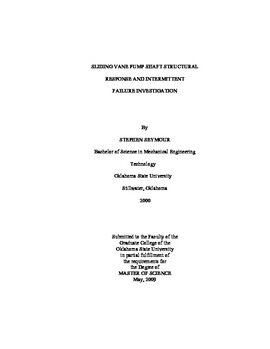| dc.contributor.author | Seymour, Stephen | |
| dc.date.accessioned | 2014-04-17T19:54:01Z | |
| dc.date.available | 2014-04-17T19:54:01Z | |
| dc.date.issued | 2009-05-01 | |
| dc.identifier.uri | https://hdl.handle.net/11244/10056 | |
| dc.description.abstract | The objectives of this study were to examine the structural response of a swept vane pump shaft subject to normal operational loading and use the results obtained from laboratory experimentation and numerical simulations to determine possible root cause pertaining to intermittent structural failure. Microscopic and SEM photographs were taken to examine the effects of the seal drive pin press fit operation on the pump shaft. Dynamic measurements of the pump discharge and pump chamber pressure were acquired at a high sample rate to study the pressures the pump shaft would be subjected to. Dynamic strain measurements of the pump shaft during the operation of the pump were also gathered through the use of telemetry data acquisition hard. Numerical simulation models involving both elastic and plastic deformations were created to simulate the press fit operation, the dynamic strain measurement experiments, and to examine the total stress when all applicable loads and interferences were applied. Research concluded that the interference fit between the seal drive pin and the pump shaft resulted in an appreciable amount of plastic deformation pertaining to the pump shaft and also resulted in levels of stress that were approaching the endurance limit of the material. Subsequent numerical simulation models that included all applicable loads and interference fits revealed stress levels that exceeded the endurance limit of the material. However, all experimentation and numerical simulation models were conducted on geometry at the nominal design dimensions. Tolerance analysis revealed a wide range of interference between the seal drive pin and the shaft, which would result in dramatic changes in the amount of plastic deformation and the magnitudes of the surrounding stresses. The press fit operation was perceived as being a major source of variability, which would contribute to the overall intermittent nature of the pump shaft failures. In addition, results stemming from the pump discharge/pump chamber pressure testing and the dynamic strain measurement experimentation revealed the presence of liquid compression, which serve to increase the levels of stress and reduce the overall serviceable life of the pump shaft. | |
| dc.format | application/pdf | |
| dc.language | en_US | |
| dc.publisher | Oklahoma State University | |
| dc.rights | Copyright is held by the author who has granted the Oklahoma State University Library the non-exclusive right to share this material in its institutional repository. Contact Digital Library Services at lib-dls@okstate.edu or 405-744-9161 for the permission policy on the use, reproduction or distribution of this material. | |
| dc.title | Sliding Vane Pump Shaft Structural Response and Intermittent Failure Investigation | |
| dc.type | text | |
| osu.filename | Seymour_okstate_0664M_10221.pdf | |
| osu.college | Engineering, Architecture, and Technology | |
| osu.accesstype | Open Access | |
| dc.description.department | Mechanical & Aerospace Engineering | |
| dc.type.genre | Thesis | |
